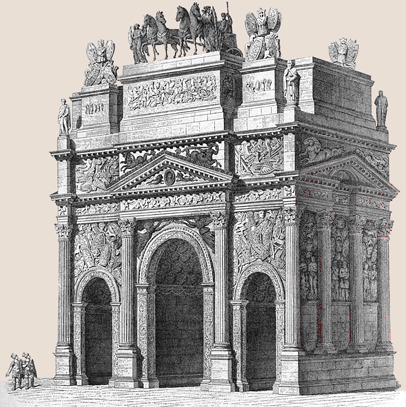Roman Uses of the Orders
OVERVIEW
Structural Use of the Orders
In Roman architecture, the orders continued to be used structurally in places where support for the roof was needed but a solid wall was not.
Columns were commonly used to support porch roofs on civic buildings and temples, which differed from Greek temples in not having free-standing columns all the way around.
Columns were also used inside buildings such as basilicas to support the roof and divide the space.
Decorative Use of the Orders
The Romans handled the orders with a new imaginative freedom and used columns decoratively to give utilitarian arcuated structures an appearance of formality and tradition.
Monumental Use of Columns
The Romans used columns singly as monuments in forums. This practice had precedent in the urban architecture of ancient Greece.
Although they were crowned by statues, colossal free-standing columns formed the main element of these monuments in which the column was at once functional as a support and decorative as a monument.
Monumental Roman columns reached their zenith in size and decorativeness with the Column of Trajan and the Column of Marcus Aurelius, which were both ceremonially Christianized and given Christian finials by Pope Sixtus V.
VARIATIONS ON THE COLUMN FORM AND USE
Decorative Variants of the Column
The Romans invented two variations on the column that facilitated its application to arcuated structures as decoration.
●Pilasters. The pilaster is a flattened version of a column in which the column is reduced to a decorative strip having the standard parts and proportions of the orders. As illustrated by the use of column-like devices on the upper story of an Etruscan gate in Perugia, this practice had precedent in Etruscan architecture.
●Engaged columns. A column that appears to be embedded in a wall is an engaged column. Sometimes whole columns were built into a wall, as they were at the Monument to Lysicrates, but usually 1/2- or 3/4-round columns with flat backs were attached to the wall.
Columns Used to Carry Arcades
The first use of columns to carry arcades, which were typically supported by piers, did not take place until late in Roman history. Their use at Diocletian's Palace in Split, Croatia would not have been known to Italians in the Renaissance.
VARIATIONS ON THE ENTABLATURE FORM
Broken Entablatures
In the hands of Roman architects, entablatures were often "broken" in plane by projections called ressauts, which are located above columns.
Curved Entablatures
Entablatures were curved to reflect circular architectural features such as apses, round temples, or temples with scalloped perimeters, seen in some late Roman examples.
VARIATIONS ON THE PEDIMENT FORM
Small-Scale Pediments
Pediments were sometimes taken out of their traditional role as the gable ends of temples and used on a smaller scale as part of a frame.
In conjunction with columns, pediments were used to create tabernacles, niches that served as religious shrines.
In late Roman architecture, pediments were sometimes used as decorative caps above openings. As decorative caps, triangular pediments might be alternated with segmental pediments, whose upper member is an arc of less than a semicircle.
Pediments Containing Arches
The pediment's characteristic triangular shape was sometimes modified by the projection of an arch through the bottom cornice.
Pediments with Broken Planes
Pediments were also broken in plane and used in fragmented form.
GENERAL PLACEMENT OF THE ORDERS
Placement on Arches and Arcades
When used as decoration in Roman architecture, the orders were most commonly placed on arches and arcades so that columns were centered on piers and entablatures passed above arches. The combination of arches decorated by columns carrying an entablature is the principal motif of the triumphal arch.
Some architectural historians refer to this combination as the arch order.
Placement on Multiple Stories
The orders are often superimposed on successive stories of arcades. Usually each story has a different order, and their arrangement follows an upward progression from heavy (Doric engaged columns) to light (Corinthian pilasters).



 Add Placemark
Add Placemark Go Back
Go Back 





